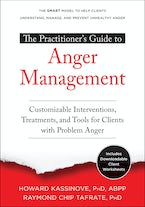By Howard Kassinove, PhD, ABPP, and Raymond Chip Tafrate, PhD
Part four of a four-part series on anger
In the heat of the moment, we all think our anger is justified. Unfortunately, focusing solely on the “bad” actions of others feeds our own self-centered view of the world. We do this both by repeatedly thinking about what happened, and by telling the story to others—from our point of view. To make matters worse, anger can be self-reinforcing. The more we ruminate about unfairness at the hands of others, the more we convince ourselves that our perspective is morally correct. After all, who wouldn’t agree that their anger is justified if they discovered their spouse or partner was cheating on them, a business partner was stealing money, or trusted friends were spreading gossip. There is also an unspoken correlate in these kinds of situations: Angry ruminations will somehow be helpful.
Whether morally justified or not, the outcome of ruminative, continuing anger is generally not productive and is, in fact self-destructive. As Buddha reportedly said, “Holding on to anger is like grasping a hot coal with the intent of throwing it at someone else; you are the one who gets burned.”
In psychotherapy, the goal is to help clients reduce their strong personal anger reactions, no matter what provoked them, so that problem resolution can hopefully emerge. Continuing to be angry, bitter, and vengeful will impede reaching solutions. The process of reducing anger reactions often begins with understanding the position of the primary source of the anger. Anger is usually caused by the actions of others that are perceived to be unwanted or inappropriate. When you, or your clients, feel angry, it is common to think that others such as spouses, children, friends, colleagues, other drivers, and so forth, have acted unfairly or wrongly. The truth, however, is that others are simply acting in their own self-interest, and their behavior is influenced by a multitude of factors. They are not necessarily motivated by evil intentions or maliciously seeking to cause harm to others.
A tip for halting unproductive rumination: Practice empathy and seeing the problem from the perspective of the other person. Just to be clear, empathy refers to situations where you truly understand the behavior, thoughts, and feelings of others but may not share them (e.g., you understand the reasons your partner voted for a different political candidate, but you intellectually disagree). Once empathy (i.e., understanding) is achieved, anger naturally diminishes.
Taking another’s perspective about a problem is one way to achieve empathy and anger reduction. Yet the process can be uncomfortable and challenging. Here are three steps to get started:
- In your office, or in a quiet and private place, have your clients clearly identify the situation that led to their anger. Direct them to not exaggerate what happened, and to keep to the specific situation.
- Out loud, have clients objectively review the specific situation from their perspective. Include the trigger, what the client was thinking at the time, and the outcome of the event. Direct them to resist the temptation to add inflammatory language such as, “He always does that,” or, “She is so selfish and stupid!”
- Now have clients review the situation, but this time, have them pretend to be the other person. Encourage them to truly assume the role of the other person by using “I” language to clearly explain their rationale for why they did what they did (as the other person). Direct them to not make silly excuses. Rather, clients objectively report on what happened from the other person’s perspective. Such reports might include nuances such as feeling conflicted about a course of action. Again, have the client do this aloud, either in the office or while they are alone in a private environment. Practice is important, so have clients repeat the perspective-taking process aloud three times.
In addition, we encourage clients to generate several possible and realistic reasons as to why the other person might have acted as they did. The goal is not to develop excuses for bad behavior. Rather, the goal is to develop understanding, reduce anger, and eventually explore the potential for a plan so the problem is less likely to reoccur in the future.
Catching up on the series? Read parts one, two, or three now.
Howard Kassinove, PhD, ABPP, is a board-certified clinical psychologist, former chairperson of the psychology department at Hofstra University, and past director of their PhD program in clinical and school psychology. Kassinove is a fellow of the American Psychological Association, the American Psychological Society, the Albert Ellis Institute, and the Behavior Therapy and Research Society. Editor of Anger Disorders, he has published more than sixty papers, and has lectured widely in the United States, Europe, and Asia.
Raymond Chip Tafrate, PhD, is a clinical psychologist, and professor in the criminology and criminal justice department at Central Connecticut State University. He is a fellow and supervisor at the Albert Ellis Institute in New York City, NY; and a member of the Motivational Interviewing Network of Trainers. He frequently consults with criminal justice agencies and programs regarding difficult-to-change problems such as anger dysregulation and criminal behavior. He has coauthored numerous books, and has presented his research throughout North America, Europe, Asia, and Australia. He is coauthor, with Howard Kassinove, of the popular self-help classic, Anger Management for Everyone.



 2024 Peace Playbook: 3 Tactics to Avoid Clashes with Your Partner
2024 Peace Playbook: 3 Tactics to Avoid Clashes with Your Partner